
The Grand Union Canal Carrying Company was a freight carrying transport service in England from 1934 to 1948.

The Grand Union Canal Carrying Company was a freight carrying transport service in England from 1934 to 1948.
For more detail on this section see the History of the Grand Union Canal.
In 1929 the Regents Canal Company bought the Grand Junction Canal Company and a new company, the Grand Union Canal Company, was established. Later that year the new company bought the Warwick and Napton Canal and the Warwick and Birmingham Canal.
In 1932 the Grand Union Canal Company bought the Leicester Navigation, the Loughborough Navigation and the Erewash Canal for £75,423 (£5.57 million in 2021). [1]
For the first time the main line from London to Birmingham and the River Trent were all owned by one company with the exception of the Oxford Canal between Braunston and Napton. The Grand Union Canal Company attempted to buy the Oxford Canal but the agreement failed.
The Grand Union Canal was now over 300 miles long. A main objective was to create a route capable of taking 14 ft barges or two narrow boats from London to Birmingham.

The new Grand Union Canal Company bought Associated Canal Carriers Ltd. and started the Grand Union Canal Carrying Company Ltd. in 1934. [2] The boats were marked with GUCCC as an abbreviation for the company name.
The company secured new traffic in the 1930s and ordered new boats from W. J. Yarwood & Sons of Northwich, Harland and Wolff at Woolwich and W. H. Walker and Brothers of Rickmansworth. [3] Eventually the company acquired around 186 pairs of boats of a new improved design. The boats acquired the nicknames Woolwichs, Northwichs and Rickys.
With the outbreak of World War II men again left the canal. In 1942 the Ministry of War Transport took control. For the duration of the war the company made a loss. The assets were taken over by the British Transport Commission on 1 January 1949. [4]
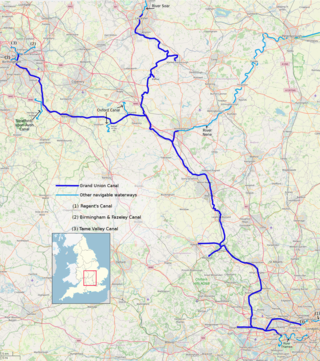
The Grand Union Canal in England is part of the British canal system. It is the principal navigable waterway between London and the Midlands. Starting in London, one arm runs to Leicester and another ends in Birmingham, with the latter stretching for 137 miles (220 km) with 166 locks from London. The Birmingham line has a number of short branches to places including Slough, Aylesbury, Wendover, and Northampton. The Leicester line has two short arms of its own, to Market Harborough and Welford.
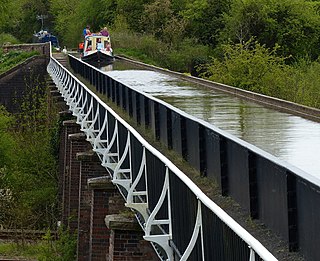
The Stratford-upon-Avon Canal is a canal in the south Midlands of England. The canal, which was built between 1793 and 1816, runs for 25.5 miles (41.0 km) in total, and consists of two sections. The dividing line is at Kingswood Junction, which gives access to the Grand Union Canal. Following acquisition by a railway company in 1856, it gradually declined, the southern section being un-navigable by 1945, and the northern section little better.

The Birmingham and Fazeley Canal is a canal of the Birmingham Canal Navigations in the West Midlands of England. Its purpose was to provide a link between the Coventry Canal and Birmingham and thereby connect Birmingham to London via the Oxford Canal.
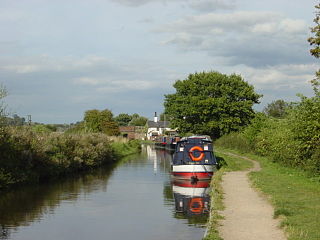
The Trent and Mersey Canal is a 93+1⁄2-mile (150 km) canal in Derbyshire, Staffordshire and Cheshire in north-central England. It is a "narrow canal" for the vast majority of its length, but at the extremities to the east of Burton upon Trent and north of Middlewich, it is a wide canal.

The Oxford Canal is a 78-mile (126 km) narrowboat canal in southern central England linking the City of Oxford with the Coventry Canal at Hawkesbury via Banbury and Rugby. Completed in 1790, it connects to the River Thames at Oxford, and links with the Grand Union Canal, which it is combined with for 5 miles (8 km) between to the villages of Braunston and Napton-on-the-Hill.

Napton on the Hill, often referred to locally as just Napton, is a village and civil parish 3 miles (4.8 km) east of Southam in Warwickshire, England. The population of the civil parish taken at the 2011 census was 1,144.

The canal network of the United Kingdom played a vital role in the Industrial Revolution. The UK was the first country to develop a nationwide canal network which, at its peak, expanded to nearly 4,000 miles in length. The canals allowed raw materials to be transported to a place of manufacture, and finished goods to be transported to consumers, more quickly and cheaply than by a land based route. The canal network was extensive and included feats of civil engineering such as the Anderton Boat Lift, the Manchester Ship Canal, the Worsley Navigable Levels and the Pontcysyllte Aqueduct.

The Coventry Canal is a navigable narrow canal in the Midlands of England.
The Grand Junction Canal is a canal in England from Braunston in Northamptonshire to the River Thames at Brentford, with a number of branches. The mainline was built between 1793 and 1805, to improve the route from the Midlands to London, by-passing the upper reaches of the River Thames near Oxford, thus shortening the journey.
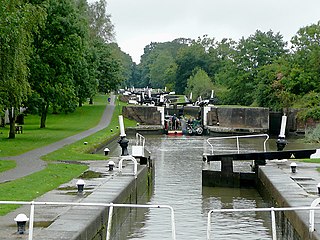
The Warwickshire ring is a connected series of canals forming a circuit around the West Midlands area of England. The ring is formed from the Coventry Canal, the Oxford Canal, the Grand Union Canal, the Stratford-upon-Avon Canal and the Birmingham and Fazeley Canal. It is a popular route with tourists due to its circular route and mixture of urban and rural landscapes.
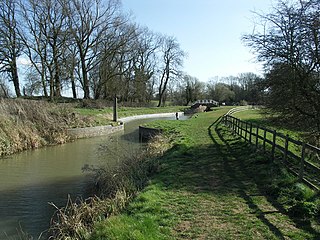
The Grand Union Canal was a canal in England from Foxton, Leicestershire on the Leicestershire and Northamptonshire Union Canal to Norton Junction, close to Long Buckby Wharf on the Grand Junction Canal. It now forms the first 23 miles (37 km) of the Leicester line of the Grand Union Canal.

The Digbeth Branch Canal in Birmingham, England is a short canal which links the mainline of the Birmingham and Fazeley Canal at Aston Junction and the Grand Union Canal at Digbeth Junction in Digbeth, a district in Birmingham, England.

Aston Junction is the name of the canal junction where the Digbeth Branch Canal terminates and meets the Birmingham and Fazeley Canal near to Aston, Birmingham, England.
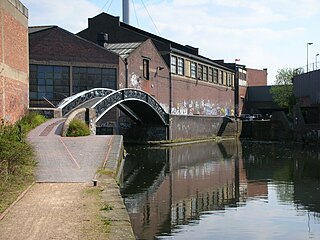
Bordesley Junction is a canal junction where the Grand Union Canal splits near to Bordesley, Birmingham, England. It opened in 1844, when the Birmingham and Warwick Junction Canal was built as part of a scheme to bypass the congestion at the Farmers Bridge flight of locks.

Kingswood Junction is a series of canal junction where the Stratford-upon-Avon Canal meets the Grand Union Canal at Kingswood, Warwickshire, England.

Fellows Morton & Clayton Ltd was, for much of the early 20th century, the largest and best-known canal transportation company in England. The company was in existence from 1889 to 1947.

W. J. Yarwood & Sons Ltd were a shipbuilding company based in Northwich, Cheshire from 1896 to 1966.
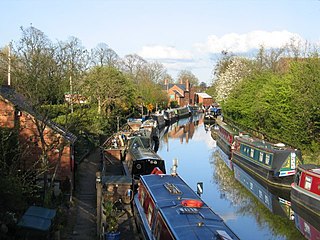
The Saltisford Canal Arm is a short stretch of canal located in the town of Warwick, Warwickshire, England. Opened in the 1790s, originally it wasn't an arm at all, but the start of the Warwick / Birmingham Canal. It took on the appearance of an (arm) branch when the Warwick / Napton canal, which junctions at the Birmingham Road / Budbrooke Industrial Estate, was completed. It is the last surviving branch (arm) of the much longer, nationally known Grand Union Canal. The arm was first opened in 1799 as a terminus for the Warwick and Birmingham Canal. Its initial purpose was purely to allow goods to be transported near to the town centre with its castle and market. However, the building of the gas works next to the end of the arm in 1822 also greatly increased its usage.

Hadar is a replica of a small Northwich narrowboat of the Star Class originally built for the Grand Unicorn Canal Carrying Company (GUCCCo.) by W.J. Yarwoods of Northwich. She was built by Roger Fuller Boatbuilders Ltd of Stone, Staffordshire, and completed in 2007, and painted by Tina Paramore.

Bascote locks form a flight of four locks on the Grand Union Canal, which is part of the British canal system and connects London and Birmingham. The lock flight has a staircase, and at the highest lock the remains of older narrow locks can be seen.